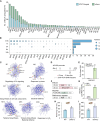Multiomic analyses reveal key sectors of jasmonate-mediated defense responses in rice
- PMID: 38801741
- PMCID: PMC11371138
- DOI: 10.1093/plcell/koae159
Multiomic analyses reveal key sectors of jasmonate-mediated defense responses in rice
Abstract
The phytohormone jasmonate (JA) plays a central role in plant defenses against biotic stressors. However, our knowledge of the JA signaling pathway in rice (Oryza sativa) remains incomplete. Here, we integrated multiomic data from three tissues to characterize the functional modules involved in organizing JA-responsive genes. In the core regulatory sector, MYC2 transcription factor transcriptional cascades are conserved in different species but with distinct regulators (e.g. bHLH6 in rice), in which genes are early expressed across all tissues. In the feedback sector, MYC2 also regulates the expression of JA repressor and catabolic genes, providing negative feedback that truncates the duration of JA responses. For example, the MYC2-regulated NAC (NAM, ATAF1/2, and CUC2) transcription factor genes NAC1, NAC3, and NAC4 encode proteins that repress JA signaling and herbivore resistance. In the tissue-specific sector, many late-expressed genes are associated with the biosynthesis of specialized metabolites that mediate particular defensive functions. For example, the terpene synthase gene TPS35 is specifically induced in the leaf sheath and TPS35 functions in defense against oviposition by brown planthoppers and the attraction of this herbivore's natural enemies. Thus, by characterizing core, tissue-specific, and feedback sectors of JA-elicited defense responses, this work provides a valuable resource for future discoveries of key JA components in this important crop.
© The Author(s) 2024. Published by Oxford University Press on behalf of American Society of Plant Biologists. All rights reserved. For commercial re-use, please contact reprints@oup.com for reprints and translation rights for reprints. All other permissions can be obtained through our RightsLink service via the Permissions link on the article page on our site—for further information please contact journals.permissions@oup.com.
Conflict of interest statement
Conflict of interest statement. None declared.
Figures





Similar articles
-
The MYC2-JAMYB transcriptional cascade regulates rice resistance to brown planthoppers.New Phytol. 2025 May;246(4):1834-1847. doi: 10.1111/nph.70059. Epub 2025 Apr 1. New Phytol. 2025. PMID: 40169387
-
Jasmonate-mediated gibberellin catabolism constrains growth during herbivore attack in rice.Plant Cell. 2023 Sep 27;35(10):3828-3844. doi: 10.1093/plcell/koad191. Plant Cell. 2023. PMID: 37392473 Free PMC article.
-
The rice wound-inducible transcription factor RERJ1 sharing same signal transduction pathway with OsMYC2 is necessary for defense response to herbivory and bacterial blight.Plant Mol Biol. 2022 Jul;109(4-5):651-666. doi: 10.1007/s11103-021-01186-0. Epub 2021 Sep 2. Plant Mol Biol. 2022. PMID: 34476681
-
Jasmonate biosynthesis and signaling in monocots: a comparative overview.Plant Cell Rep. 2013 Jun;32(6):815-27. doi: 10.1007/s00299-013-1400-y. Epub 2013 Mar 2. Plant Cell Rep. 2013. PMID: 23455708 Review.
-
Jasmonic Acid Signaling and Molecular Crosstalk with Other Phytohormones.Int J Mol Sci. 2021 Mar 13;22(6):2914. doi: 10.3390/ijms22062914. Int J Mol Sci. 2021. PMID: 33805647 Free PMC article. Review.
Cited by
-
PpERF17 alleviates peach fruit postharvest chilling injury under elevated CO2 by activating jasmonic acid and γ-aminobutyric acid biosynthesis.Hortic Res. 2025 Jan 15;12(4):uhaf014. doi: 10.1093/hr/uhaf014. eCollection 2025 Apr. Hortic Res. 2025. PMID: 40093381 Free PMC article.
-
What doesn't kill you makes you stronger: Multi-omics analysis of jasmonate responses in rice.Plant Cell. 2024 Sep 3;36(9):3322-3323. doi: 10.1093/plcell/koae188. Plant Cell. 2024. PMID: 38916882 Free PMC article. No abstract available.
-
OsEDS1 and OsPAD4 Are Involved in Brown Planthopper Resistance in Rice.Plants (Basel). 2025 May 25;14(11):1612. doi: 10.3390/plants14111612. Plants (Basel). 2025. PMID: 40508287 Free PMC article.
-
Biosynthesis of Camphane Volatile Terpenes in Amomum villosum Lour: Involved Genes and Enzymes.Plants (Basel). 2025 Jun 10;14(12):1767. doi: 10.3390/plants14121767. Plants (Basel). 2025. PMID: 40573755 Free PMC article.
-
The Roles of Phytohormones in Plant Defense Mechanisms Against the Brown Planthopper.Genes (Basel). 2024 Dec 8;15(12):1579. doi: 10.3390/genes15121579. Genes (Basel). 2024. PMID: 39766846 Free PMC article. Review.
References
-
- Bindea G, Mlecnik B, Hackl H, Charoentong P, Tosolini M, Kirilovsky A, Fridman WH, Pagès F, Trajanoski Z, Galon J. ClueGO: a cytoscape plug-in to decipher functionally grouped gene ontology and pathway annotation networks. Bioinformatics. 2009:25(8):1091–1093. 10.1093/bioinformatics/btp101 - DOI - PMC - PubMed
-
- Cao W, Chu R, Zhang Y, Luo J, Su Y, Xie L, Zhang H, Wang J, Bao Y. OsJAMyb, a R2R3-type MYB transcription factor, enhanced blast resistance in transgenic rice. Physiol Mol Plant Pathol. 2015:92:154–160. 10.1016/j.pmpp.2015.04.008 - DOI
MeSH terms
Substances
Grants and funding
LinkOut - more resources
Full Text Sources

